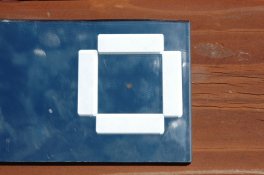I have been less than successful in completing a satisfactory alignment on my enlargers so I decided to improve on the mirror concept. I made some changes to the basic instructions I found on the web and now have a very accurate and simple (inexpensive) alignment tool that is quite sensitive. I can detect a few thousandths of movement quite easily. I was unable to achieve a good alignment using the tiny donut hole.
I bought a 12"x12" mirror at the craft store and split it into 3-4" widths by 12" long. I scraped out a hole about 3/16" for viewing and added four Avery labels (3/4"x1-1/2") and assembled them into box shape about 1-1/2" square (id).
This 4x12" mirror is placed mirror down inserted into the negative stage. Another 4x12" mirror is rotated 90 degrees and placed mirror side up on the baseboard. The enlarger was raised to the height to make an 8x10.
View down through the 3/16" hole and you will see the succession of boxes disappearing into the center (when properly aligned). Also, if you leave a slight gap between the corners of the Avery labels (I didn't leave much and am going to modify mine in the future), you will see a darkish 'X' disappearing into the center. Adjust enlarger for concentric boxes and the 'X' sinking into the center. You can see the center of the X shift with the slightest movement of the negative stage adjustments.
I could never get a proper presentation with the donut hole arrangement and this presentation is extremely sensitive and it is very easy to do a check before a printing session....and it doesn't cost hundreds of $$$.
Checking the lens stage isn't quite as simple as I have to hold the mirror up against the rim of the enlarging lens with the presumption that the rim is square with the optical axis. Also, there is the probability that upward pressure on the lens rim will change the position of the head and bias the alignment. I am going to work on find a way to attach the top mirror to the lens without me holding it in place. I am going to experiment with large rubber bands around the mirror and negative stage snugging it up against the rim. Any suggestions would be appreciated.
Bottom line: I have an enlarger that doesn't have lens stage adjustments but is parallel with the negative stage. When I finished, I checked grain with a Peak 2020 and have the best alignment corner to corner I have had in some time.
Fred
Please excuse the fingerprints on the mirror in the photo.
I bought a 12"x12" mirror at the craft store and split it into 3-4" widths by 12" long. I scraped out a hole about 3/16" for viewing and added four Avery labels (3/4"x1-1/2") and assembled them into box shape about 1-1/2" square (id).
This 4x12" mirror is placed mirror down inserted into the negative stage. Another 4x12" mirror is rotated 90 degrees and placed mirror side up on the baseboard. The enlarger was raised to the height to make an 8x10.
View down through the 3/16" hole and you will see the succession of boxes disappearing into the center (when properly aligned). Also, if you leave a slight gap between the corners of the Avery labels (I didn't leave much and am going to modify mine in the future), you will see a darkish 'X' disappearing into the center. Adjust enlarger for concentric boxes and the 'X' sinking into the center. You can see the center of the X shift with the slightest movement of the negative stage adjustments.
I could never get a proper presentation with the donut hole arrangement and this presentation is extremely sensitive and it is very easy to do a check before a printing session....and it doesn't cost hundreds of $$$.
Checking the lens stage isn't quite as simple as I have to hold the mirror up against the rim of the enlarging lens with the presumption that the rim is square with the optical axis. Also, there is the probability that upward pressure on the lens rim will change the position of the head and bias the alignment. I am going to work on find a way to attach the top mirror to the lens without me holding it in place. I am going to experiment with large rubber bands around the mirror and negative stage snugging it up against the rim. Any suggestions would be appreciated.
Bottom line: I have an enlarger that doesn't have lens stage adjustments but is parallel with the negative stage. When I finished, I checked grain with a Peak 2020 and have the best alignment corner to corner I have had in some time.
Fred
Please excuse the fingerprints on the mirror in the photo.




